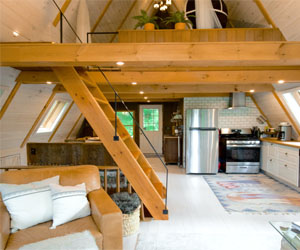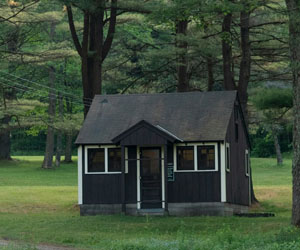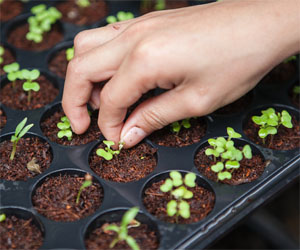


The Art Of Minimalist Living

In a world where consumerism often pushes us to acquire more, the concept of simplifying your space has gained significant traction. Minimalist living is about embracing the idea that less is more, and it's not just a design trend; it's a lifestyle choice that can bring a sense of peace, order, and clarity to your life. Here, we'll explore the principles of simplifying your space and how it can lead to a happier, more intentional life.
Declutter And Downsize
The first step in simplifying your space is to declutter and downsize. Take a critical look at your belongings and ask yourself what truly adds value to your life. Consider the Marie Kondo approach of keeping only those items that "spark joy." Donate or sell what you no longer need, and let go of the excess.
Create Functional Spaces
A simplified space is a functional one. Ensure that every item has its place and purpose. This not only makes it easier to find what you need but also reduces visual clutter. Design your spaces with intention, and be mindful of the flow and purpose of each area.
Choose Quality Over Quantity
In the pursuit of simplification, focus on quality over quantity. Invest in well-made, durable items that are built to last. This not only reduces the need for constant replacements but also brings a sense of craftsmanship and beauty to your space.
Declutter Digitally
In our digital age, it's not just physical clutter that can overwhelm us; digital clutter can be equally burdensome. Simplify your digital life by organizing files, emails, and apps. Unsubscribe from unnecessary emails and unfollow social media accounts that don't bring value to your life.
Reduce Decor
In a simplified space, less is often more when it comes to decor. Choose a few meaningful pieces that resonate with you, rather than overwhelming your space with decorations. This approach can create a serene atmosphere and highlight the items that truly matter.
Simplify Your Wardrobe
A simplified wardrobe can be liberating. Consider creating a capsule wardrobe, a collection of versatile pieces that can be mixed and matched. Fewer clothes mean less decision fatigue and a streamlined morning routine.
Organize Your Home Mindfully
Mindful organization is at the heart of simplifying your space. Use storage solutions that are both functional and aesthetically pleasing. Clear storage containers, labels, and custom storage solutions can make a significant difference in keeping your space organized.
Embrace Open Spaces
Open spaces are a hallmark of a simplified home. Allow areas of your home to breathe by reducing clutter. This not only makes cleaning and maintenance easier but also creates a sense of calm and tranquility.
Slow Down And Savor
In our fast-paced world, a simplified space can remind us to slow down and savor life's moments. Embrace a mindful approach to living, where you're not rushed by the need to manage excessive possessions.
Environmental Impact
Simplifying your space can have a positive environmental impact. By consuming less and making more intentional choices, you reduce your ecological footprint, which is especially important in a world facing environmental challenges.
Simplifying your space is a lifestyle choice that can bring a myriad of benefits, from reduced stress and enhanced focus to a more sustainable, eco-conscious life. By decluttering, organizing with intention, and embracing a minimalist mindset, you can create a space that promotes well-being and allows you to live more fully and intentionally. So, take a step back, reevaluate your space, and embark on a journey toward a simpler, more meaningful life.
A Step Toward Sustainable Living
 Why Environmentally Mindful Cleaning Matters
Why Environmentally Mindful Cleaning Matters
Traditional cleaning products often contain harsh chemicals and synthetic fragrances that can have adverse effects on our health and the environment. These chemicals, when washed down the drain, find their way into waterways, harming aquatic life and affecting the quality of our drinking water. Moreover, indoor air pollution caused by the release of volatile organic compounds (VOCs) from cleaning products can lead to respiratory problems and other health issues.
Environmentally mindful cleaning is about recognizing the interconnectedness of our actions. It's not just about making our immediate surroundings cleaner; it's about preserving the planet for future generations. By making eco-conscious choices in our cleaning routines, we can significantly reduce our ecological footprint and contribute to a healthier world.
The Green Cleaning Revolution
The shift towards environmentally mindful cleaning practices has given rise to a green cleaning revolution. This movement encourages the use of natural, non-toxic, and sustainable alternatives to conventional cleaning products. Some of the key elements of this revolution include:
Natural Ingredients: Many common household items like vinegar, baking soda, lemon juice, and essential oils can serve as powerful cleaning agents. They are safe, effective, and readily available.




A Path To Sustainability And Well-Being
 Harmony with nature is not merely an abstract ideal; it is a practical and philosophical approach to life that has profound implications for our environment, mental well-being, and the future of our planet.
Harmony with nature is not merely an abstract ideal; it is a practical and philosophical approach to life that has profound implications for our environment, mental well-being, and the future of our planet.
At its core, harmony with nature emphasizes the interconnectedness of all living things. It acknowledges that humans are not separate from the environment but an integral part of it. When we live in harmony with nature, we treat the Earth and its resources with respect, realizing that our actions have consequences not only for the planet but for future generations.
One of the fundamental principles of harmonious living is sustainability. This means using resources responsibly, minimizing waste, and conserving energy. Sustainable practices include reducing, reusing, and recycling, and making choices that have a lesser impact on the environment. By embracing sustainability, we reduce pollution, conserve biodiversity, and decrease our carbon footprint.
Harmony with nature also fosters a deep appreciation for the natural world. People who live in harmony with nature often spend more time outdoors, cultivating a sense of wonder and gratitude for the Earth's beauty. This connection to nature has been linked to improved mental and emotional well-being, reducing stress and promoting a sense of calm and contentment.
Powering Your Home Sustainably
 The Rise Of Solar Power
The Rise Of Solar Power
Solar power has become a mainstream energy source, and its use in residential settings is on the rise. Homeowners are increasingly turning to solar panels to generate their electricity, and it's not difficult to understand why. Solar power offers an array of advantages, making it an attractive choice for environmentally conscious individuals.
Eco-Friendly Energy
One of the primary benefits of residential solar solutions is their eco-friendliness. Solar panels harness the energy of the sun, a renewable resource, and convert it into electricity. Unlike traditional fossil fuels, solar power does not produce harmful emissions, making it a clean and green energy source. By switching to solar energy, homeowners significantly reduce their carbon footprint and contribute to a healthier planet.
Lower Energy Bills
Solar panels not only benefit the environment but also your wallet. Once you've invested in a solar panel system for your home, you'll enjoy reduced energy bills. Solar power systems can generate a substantial portion of your electricity needs, which means you'll buy less power from the grid.
Compact Living With A Sustainable Touch
 Sustainability: Small footprint homes are known for their sustainability. The reduced size and efficient design mean fewer materials are needed for construction, resulting in a smaller environmental footprint. Many small footprint homes also incorporate eco-friendly materials and energy-efficient systems.
Sustainability: Small footprint homes are known for their sustainability. The reduced size and efficient design mean fewer materials are needed for construction, resulting in a smaller environmental footprint. Many small footprint homes also incorporate eco-friendly materials and energy-efficient systems.
Cost-Effective: Smaller homes are generally more affordable, making homeownership accessible to a broader range of people. Reduced utility costs and maintenance expenses contribute to long-term savings.
Minimalism: Small footprint living encourages minimalism, a lifestyle that prioritizes quality over quantity and focuses on reducing clutter and material possessions. This approach often leads to a simpler, less stressful way of life.
Mobility: Some small footprint homes are built on wheels or designed for easy relocation. This provides homeowners with the freedom to move or travel as they wish, leading to a more mobile and adventurous lifestyle.
Energy Efficiency: Smaller spaces are easier to heat and cool, resulting in lower energy consumption. Many small footprint homes incorporate energy-efficient appliances, solar panels, and other sustainable technologies to further reduce their carbon footprint.
Community Living: Some small footprint housing developments encourage community living. Shared spaces and communal facilities foster social interaction and a sense of belonging among residents.
Innovation: The small footprint housing movement has spurred innovation in design and construction. Architects and builders are coming up with creative solutions to maximize space utilization, often incorporating modular and multi-functional furniture.
 Soil Testing: Start with a soil test to determine its pH level and nutrient content. This guides you in making necessary adjustments.
Soil Testing: Start with a soil test to determine its pH level and nutrient content. This guides you in making necessary adjustments.
Clear The Area: Remove any weeds, rocks, or debris from the planting area to provide a clean slate for your garden.
Amend The Soil: Depending on the soil test results, amend your soil with organic matter like compost, well-rotted manure, or peat moss. These materials improve soil structure and nutrient content.
Till The Soil: Use a tiller or a spade to mix in the amendments and break up compacted soil. The goal is to create a loose, well-aerated soil structure.
Mulch The Surface: Apply a layer of organic mulch to conserve moisture, regulate soil temperature, and suppress weed growth.
Maintain Soil Health: Regularly test and amend your soil as needed. Crop rotation and cover cropping can also help maintain soil fertility.
Water And Monitor: After planting, water your garden beds appropriately, keeping the soil consistently moist but not waterlogged. Monitor plant health for signs of nutrient deficiencies.
Streamline Your Space And Simplify Your Life

1. Start Small
One of the most common mistakes when tackling clutter is trying to do too much at once. Start with a small area, like a drawer, a shelf, or a single closet. Completing one small area can give you a sense of accomplishment and motivate you to continue.
2. The One-Year Rule
If you haven't used or needed an item within the last year, consider whether it's truly necessary in your life. Apply the one-year rule when decluttering. If you haven't touched it in that time, it may be time to let it go.
3. Declutter By Category
Organize your decluttering efforts by category, not by room. For example, gather all your books, clothing, or kitchen items in one place and go through them systematically. This approach allows you to see the full extent of your possessions in that category.
4. Use The Four-Box Method
When decluttering a space, use the four-box method: one box for items to keep, one for items to donate, one for items to sell, and one for items to discard. This method helps you make decisions quickly and efficiently.
5. Minimalism In Mind
Embrace a minimalist mindset by focusing on quality over quantity.
Strategies And Implications
 Higher yields in agriculture refer to the increased production of crops, livestock, or other agricultural products per unit of land, water, or other resources. This increase in productivity is essential for several reasons:
Higher yields in agriculture refer to the increased production of crops, livestock, or other agricultural products per unit of land, water, or other resources. This increase in productivity is essential for several reasons:
1. Food Security: With a global population that continues to expand, the need for increased food production is evident. Higher yields help ensure that there is enough food to feed everyone.
2. Economic Growth: Agriculture is a significant driver of economic growth in many countries. Higher yields can boost rural economies, create jobs, and increase income for farmers and agricultural businesses.
3. Environmental Sustainability: Efficient farming practices that result in higher yields can help reduce the environmental impact of agriculture. By producing more food with fewer resources, we can minimize habitat destruction, water usage, and greenhouse gas emissions.
Strategies For Achieving Higher Yields
Numerous strategies and technologies contribute to higher yields in agriculture:
1. Improved Crop Varieties: Developing and adopting high-yielding crop varieties through selective breeding and genetic modification is a primary strategy. These varieties are often more disease-resistant and better suited to specific environmental conditions.
2. Precision Agriculture: The use of technology, such as GPS, sensors, and data analysis, allows farmers to make precise decisions about planting, irrigation, and fertilization. This optimizes resource use and boosts yields.
3. Sustainable Practices: Techniques like crop rotation, reduced tillage, and cover cropping can improve soil health and enhance crop yields while minimizing environmental harm.
4. Efficient Water Management: Implementing water-saving irrigation methods like drip or sprinkler systems can help maintain optimal soil moisture and boost crop yields.
5. Pest And Disease Management: Effective pest and disease control measures, including integrated pest management, help protect crops and prevent yield losses.